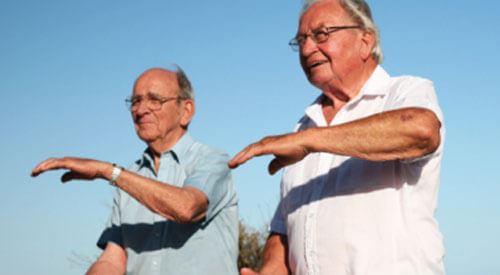
Connect the Dots: Physical Therapy + Quality Home Care = Less Chance for Hospital Readmission

Adhering to physical therapy regimens, often when supported by family or professional in home caregivers, is one way that people can reduce the risk of a fall in the home and steer clear of being readmitted to the hospital.
“Physical therapists (PTs) serve an important role in patient safety and patient care transitions,” states the American Physical Therapy Association. “PTs should advocate and communicate their expertise and critical decision making in providing recommendations for the most appropriate level of care post-acute care discharge within the health care team prior to and during care transitions to help in reducing hospital readmissions.”
October is National Physical Therapy Month and Bone and when Joint Health National Awareness Week occurs.
Be Part of the Team
When someone comes home from the hospital they are likely to have new medications, need additional assistance to perform activities of daily living such as toileting and preparing meals, or experience changes in mobility. Anyone of these factors can increase the likelihood of a fall or other complication that could, in turn, lead to a trip back to the hospital.
“Physical therapists look at where the person is functional,” said Patrice Winter, PT, DPT, MHA, FAAOMPT, and spokesperson for the American Physical Therapy Association. “This might include evaluating the home situation and how they are in their home. We want to evaluate their balance, their stair climbing, how they get articles out of washer and dryer, and more.”
Once this evaluation is complete, a physical therapist will make recommendations and this might include specific exercises to do regularly to regain strength, endurance, and balance. Ms. Winter is aware that many people avoid doing their physical therapy though.
“They think it will hurt,” she said. “Or it hurts their pride to use a cane or other assistive device.”
This avoidance—whether from a fear of pain or wounded pride—means people remain at risk for falls in the home and possibly a return to the hospital while they are recuperating.
Caregivers can help to reinforce the recommendations of the physical therapist. “A physical therapist will work with a caregiver by showing them how to do the exercises the correct way, or how to use a cane, the correct way to transfer in or out of a car safely,” said Ms. Winter, who also coordinates George Mason University’s Life Planning/Eldercare program.
Get Back in the Game
Ms. Winter suggested that people think of their physical therapist as a coach who is there to assess the strengths and weaknesses and get you back in the game.
“When we look at the rehabilitation of anyone it’s like a group activity,” she said. “If somebody has a stroke, we’re going to evaluate where a person’s skills are post-stroke and what their potential will be. As physical therapists, we want to get somebody to their highest level of possible functioning. As the coach, we look at how many people we can involve to get this client or patient to their absolute best.”
Ms. Winter said that physical therapists are limited in what they can do given that they might spend one hour a day with a patient, whereas a caregiver might be there 24 hours a day.
“I want to rally the team to make sure the patient or client has as many people helping as possible,” she said. “This might mean that when grandkids come over they can massage grandma’s sore hand, so everyone can contribute.”
The ultimate goal is a return to as much independence as possible in a safe environment.
“We want people to have a quality of life,” said Ms. Winter. “We want them to achieve their highest functionality after an illness or injury.”
-
 Paranoia in Elderly People: How to Help Your Loved One
Paranoia in Elderly People: How to Help Your Loved One -
 Yoga for Healthy Aging – Yoga for the Elderly
Yoga for Healthy Aging – Yoga for the Elderly -
 10 Healthy Meals for Seniors That Are Quick and Easy to Make
10 Healthy Meals for Seniors That Are Quick and Easy to Make



